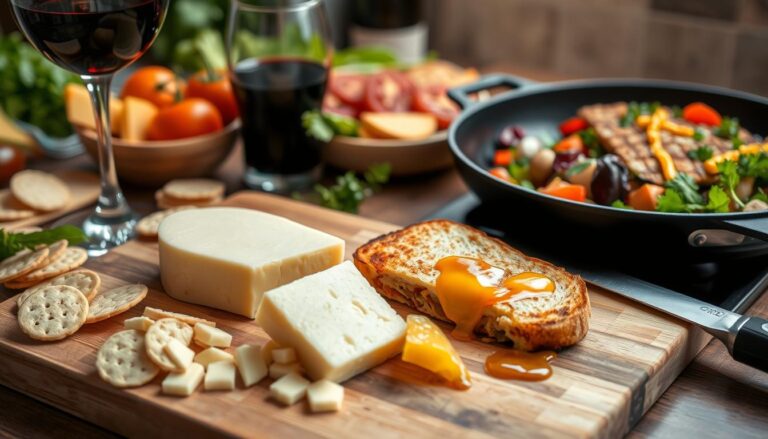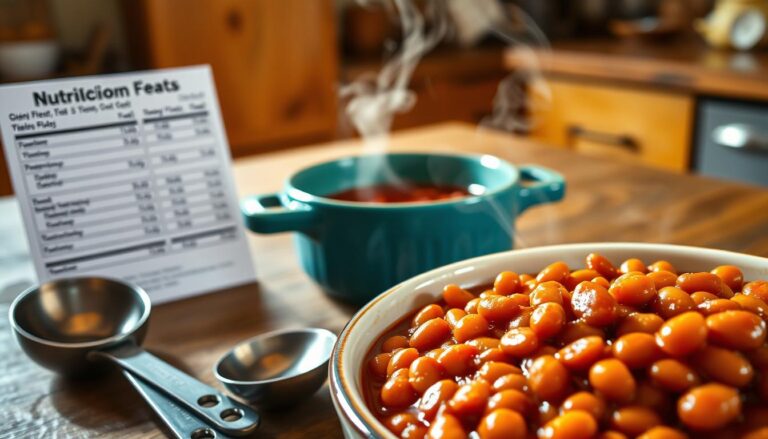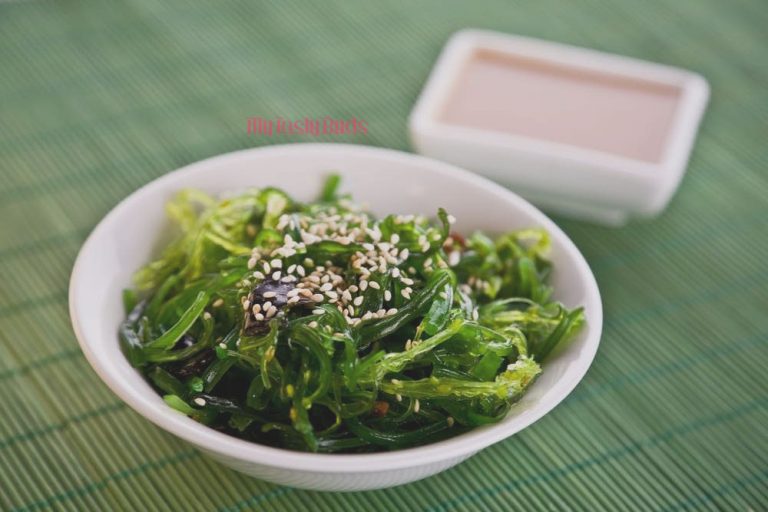Perfect Thin Ramen Noodles for Light Broths
Did you know the perfect Flour-Water Ratio for noodles is about 35%? This balance makes thin ramen noodles essential for anyone wanting the best ramen combo. Paired with light broths, these noodles capture the soup’s flavors perfectly.
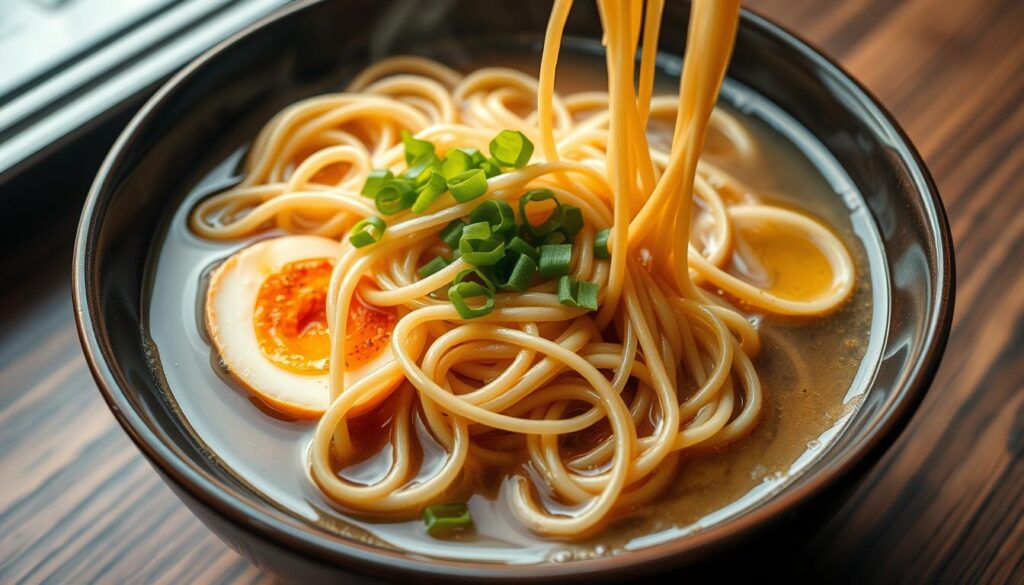
These noodles mix well with the broth’s tastes, cooking fast. They come mainly from Hakata, known for its ramen culture. Choosing thin noodles is more than a taste preference—it’s a commitment to ramen’s art, ensuring a satisfying experience.
Key Takeaways
- Thin ramen noodles are the ideal complement to light broths, enhancing the dish’s delicate flavors.
- With a 35% Flour-Water Ratio, these noodles absorb soup quickly, ensuring a well-rounded taste.
- Such noodles cook faster, making them a practical choice for a swift yet rich ramen experience.
- The choice of noodle thickness is a thoughtful consideration in crafting an authentic ramen experience.
- Thin ramen noodles carry a historical cuisine legacy originating from places like Hakata.
- Distinguishing the subtleties between noodle types and broths is key to the ultimate ramen bowl.
Understanding the Role of Noodle Thickness in Ramen
Noodle thickness deeply affects the ramen experience. It changes how the soup feels and how chewy the noodles are. Whether you like chewy noodles in a thick broth or thin ones in a light soup, knowing this can make your meals better.
Interaction of Thin Noodles and Soup
Thin noodles, like those in Hakata ramen, are great at soaking up flavors. Their design means they get fully coated, making every bite flavorful. They cook fast and are tender, perfect for when the soup’s taste is key.
Optimal Noodle Textures for Various Broths
The texture of the noodles is key for matching with broths. Chewy, thick noodles go well with heavy, creamy broths. They hold their own against strong flavors and don’t get soggy. Thin noodles work best with light broths, adding to the taste without overpowering it.
| Cutter Number | Noodle Thickness (mm) | Typical Ramen Type | Preferred Broth Style |
|---|---|---|---|
| 12 | 2.5 | Kitakata, Tsukemen | Thick, Creamy |
| 22 | 1.4 | Tokyo Shoyu | Medium, Soy-based |
| 26 | 1.2 | Standard Tonkotsu | Light, Rich Pork-based |
| 28 | 1.1 | Hakata Tonkotsu | Light, Pork-based |
In ramen, noodle thickness is critical for dish harmony. Thin noodles quickly soak up light broth flavors. Thicker noodles add a satisfying chew to rich soups. Choosing the right noodle thickness transforms the ramen experience.
Choosing the Right Thin Ramen Noodles for Your Broth
Starting your quest for the perfect ramen bowl? The right thin ramen noodles are key. They’re not just any base. They soak up and enhance your broth’s taste. Choosing them involves understanding how they absorb the broth, picking the right ones, and using a precise noodle cutter blade.
The Cutter Blade Guide for Thin Noodles
For noodle lovers, the cutter blade is crucial. The blade’s number decides the noodle’s width. This changes its texture and how it blends with the broth. For light broths like those in Hakata-style ramen, use blades #28 to #26. They make a quick-cooking, thin noodle that’s perfect for soaking up delicate flavors.
If your broth is between light and rich, like in salt ramen, choose a #24 blade. It makes slightly thicker noodles. They still absorb well but offer a bit more bite.
Balancing Texture with Noodle Absorption
Getting the balance right between noodle texture and broth absorption is crucial. Thin noodles, known for cooking fast, are great with light broths. They quickly soak up the broth. This makes every mouthful flavorful. This balance is key to highlighting the broth’s flavors, not masking them.
Choosing the best thin ramen noodles is more than just texture or simple rules. It’s about understanding how noodles change the eating experience with different broths.
Picking Noodles: The Secret Behind Light Broths
The perfect ramen dish starts with choosing the right noodles. This is especially true for light broths. Selecting thin noodles is key to the dish’s flavor and texture.
Light broths are known for their delicate flavors. Thus, noodles should match, not overpower, this taste. This idea comes from Japanese cooking, where balance is crucial.
Noodle choice focuses on complementing the broth, not taking over.
| Ramen Type | Noodle Recommendation | Broth Base | Key Ingredients |
|---|---|---|---|
| Shoyu Ramen | Curly, al dente | Chicken or pork bones, soy sauce | Chili oil, sesame seeds, green onions |
| Shio Ramen | Straight, thin | Chicken or pork bones | Bamboo shoots, fish cake, seaweed |
| Miso Ramen | Thick, wavy | Fermented soybean paste | Corn, butter, roasted pork |
Making great ramen is about knowing how each part works together. It’s not just the seasoning. It’s how noodles bring out flavors and textures. This balance turns every bite into an experience of taste and harmony.
- Noodle selection is key for the perfect slurp in light broths.
- The right noodle and broth combo brings out the best flavors. It lets subtle tastes emerge without overwhelming the senses.
Making an amazing ramen bowl is about focusing on details. From the broth’s depth to the noodles’ texture, mastering these makes for a memorable meal.
Thin Ramen Noodles: A Match for Shio and Shoyu Broths
The mix of thin ramen noodles with broths like shio ramen and shoyu ramen shows the beauty of Japanese cooking. These noodles, often from buckwheat, play a big role in ramen. They match perfectly with the light, nice-smelling broths in shio and shoyu ramen. This makes what many call the best ramen noodle pairing.
Shio ramen has a clear, salty broth that comes from slow-cooked chicken or pork bones. It has a deep taste that goes well with thin noodles. Shoyu ramen, with its soy sauce broth, pairs great with buckwheat noodles. These noodles don’t get soggy and soak up the rich flavors well.
Knowing how a broth’s taste and a noodle’s texture work together is key to a great ramen bowl. It’s not just about flavor. It’s also about how the noodles hold up in these unique broths.
| Ramen Type | Noodle Type | Broth Base | Popular Toppings |
|---|---|---|---|
| Shio Ramen | Buckwheat Flour Noodles | Light, salt-based | Menma, Green Onions |
| Shoyu Ramen | Wheat Thin Noodles | Soy sauce-infused | Chashu, Boiled Eggs |
The combo of shio and shoyu broths with the right noodles is amazing. This mix brings out the best in the broths, creating a deep taste experience. The right noodles are key, whether it’s shio’s sweet taste or shoyu’s umami. They show how important a good ramen noodle pairing is for the best ramen bowl.
Differentiating Ramen Soup Bases and Noodle Pairings
Discovering the variety of ramen is an exciting trip through taste and tradition, especially when focusing on ramen soup bases and noodle pairings. Each ramen soup base has its own flavor. It also requires specific noodles to elevate the meal.
Understanding the Complexity of Light Broths
Light broths like Shio and Shoyu are famous for their gentle, complex tastes. They open the door to flavor complexity. Being clear, they depend on a fine mix of ingredients for their unique, mild flavors. The skill in making these broths shows the need for the perfect noodle match to complement their taste.
Noodle Variety Selection for Optimal Flavor Experience
Selecting the right noodle is as important as the soup for the best optimal ramen experience. The noodle and broth must work together. The noodles should support, not hide, the soup’s flavor. Below, a table shows the top noodle pairings for different broths, improving taste and texture.
| Ramen Type | Preferred Noodle Characteristics | Regional Popularity |
|---|---|---|
| Shoyu | Straight, medium-thick, low water addition | Popular in Tokyo |
| Tonkotsu | Straight, very thin, low water addition | Prevalent in Kyushu |
| Miso | Yellow, wavy, medium-thick, high water addition | Favored in Hokkaido |
| Shio | Straight, thin to medium-thick, high water addition | Enjoyed in varying regions |
These combinations aim to match the unique flavors of the ramen soup bases. They make every sip delicious and memorable. By knowing this, ramen fans and chefs can create an amazing bowl. It honors Japan’s deep food culture.
The Art of Crafting Perfect Thin Ramen Noodles
Making ramen noodles is a deep art. It requires a mix of skill, patience, and knowledge. This is especially true for creating perfect thin ramen noodles. They stand out for their texture and how well they blend with light broths. Knowing the right noodle making skills and how much water to use is key.
Noodle Making Techniques
Learning to make amazing ramen noodles starts with mastering certain skills. Every step, from mixing and kneading the dough to rolling and cutting the noodles, matters. What you use in your dough is also important. High-gluten flour is often used because it makes the noodles chewy. Also, adding kansui, an alkaline solution, gives the noodles a firm texture and a yellow color.
Hydration Ratios in Noodle Dough
The amount of water in the dough is very important. For thin ramen noodles, you usually use less water compared to the flour. This affects the dough’s feel, how easy it is to handle, and the texture of the noodles. With less water, the noodles are firmer and soak up broth better. This makes the ramen taste better. While more water makes noodles chewier, they don’t soak up the broth as well but offer a unique taste with light broth.
- Optimal water temperature for noodle cooking: 190-200°F
- Recommended resting time for dough: 30 minutes to 2 hours depending on ambient temperature
- Ideal thickness for stretched dough: Approximately 1mm
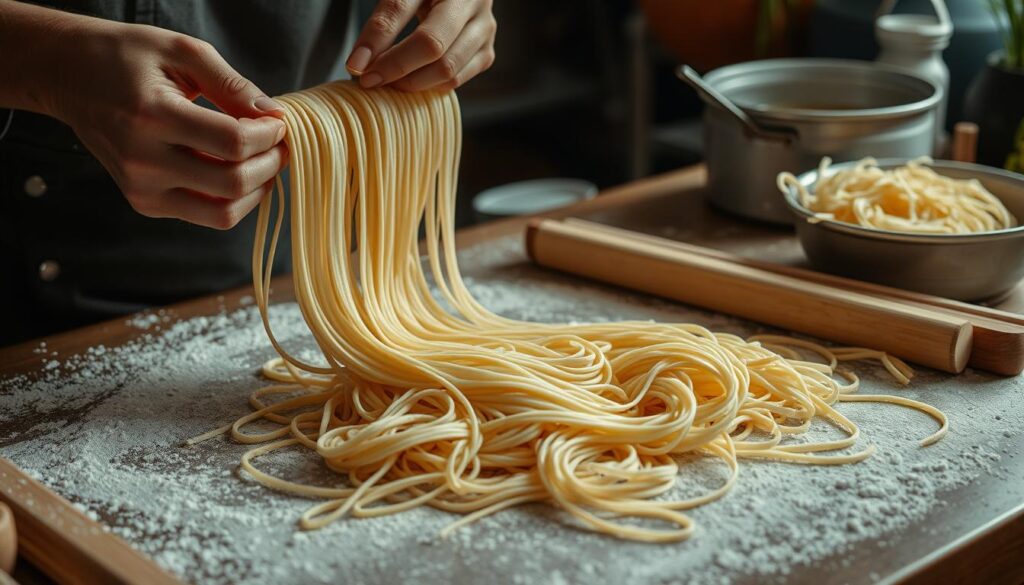
Knowing how to make ramen noodles improves homemade ramen and the eating experience. It also helps you appreciate the fine details in traditional Asian cooking. Whether you love the bright taste of shoyu broth or the creamy goodness of tonkotsu, getting better at making noodles is a journey worth taking. It leads to the very best in noodle excellence.
Thin Ramen Noodles in Regional Cuisine
In the journey through regional ramen varieties, traditional ramen noodles play a key role. They are a part of Japan’s food culture. Each area has made its own ramen, showing local tastes and what’s available.
Local ramen cuisine is more than flavor. It’s a big part of the area’s culture. For example, Kitakata loves its thick noodles, and Hakata is known for thin ones. This shows ramen’s flexibility and how local tastes influence food traditions.
The ramen story in Japan is all about changing and getting creative. It started simple, for workers who were always busy. Then, it grew to be a food icon. A big moment was in 1958 when Momofuko Ando created instant noodles. This made ramen famous worldwide.
In the 1980s, ramen became even more popular. This happened as Japanese-owned ramen shops opened. It became a top choice for people working in offices. Now, from Sapporo’s ramen spots to long lines in Onomichi, ramen is celebrated all over Japan.
Let’s look closely at how local ramen cuisine is different in each area:
- Kurume Ramen: It comes from Kyushu. This ramen has a rich tonkotsu broth that’s hearty and full of meat flavor.
- Kagoshima Ramen: This ramen stands out. Its broth mixes pork, chicken, and dried seafood for a unique taste.
- Nagasaki Champon: A mix of Chinese and Japanese cooking, this dish is both affordable and filling. It’s great for students and workers.
In the end, the variety of regional ramen shows the creativity and local genius of Japanese cooking. The special way each area makes traditional ramen noodles not only shows their ability to adapt. It also keeps their rich culture alive through this simple, meaningful dish.
Wavy vs. Straight Noodles: Knowing Your Thin Ramen Noodles
The debate between wavy ramen noodles and straight ones is big. It’s all about the unique traits of straight noodles. These differences matter a lot. They affect the dish’s texture and taste. This knowledge is vital for those who want to make the perfect ramen bowl. It’s especially important when dealing with light broth noodle shapes.
Texture and Flavor Dynamics in Thin Ramen Noodles
Thin noodles have a charm that’s hard to miss. They blend so well with broths. This blend creates a perfect mix of taste and texture. Straight thin noodles are sleek and even. They’re great for thick broths like tonkotsu, without hiding the delicate tastes. On the flip side, wavy ramen noodles bring something special. Their unique shape adds a fun contrast. This makes lighter soups, like miso and shio, more interesting with every bite.
Preferred Noodle Shapes for Light Broths
When talking about light broth noodle shapes, choosing between wavy and straight matters a lot. Straight noodles give a clearer taste and a stronger sense of the broth. Their simple texture does this trick. Wavy noodles, however, grab onto the flavor. They let the subtle tastes of the soup show slowly. This trait makes them perfect for softly flavored broths, where every taste bit counts.
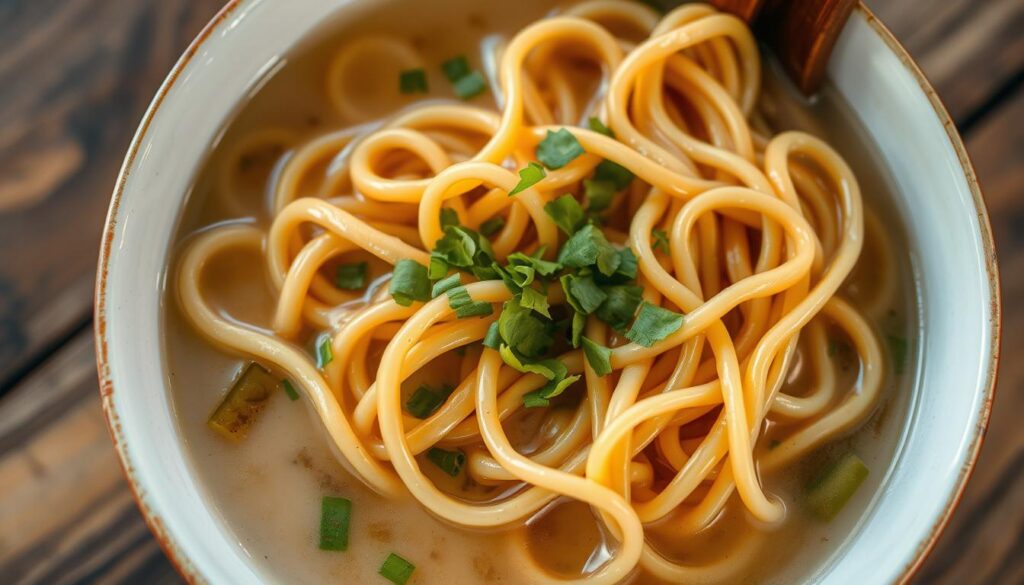
The physical traits of these noodles also affect how they hold soup and interact with flavors. Here’s a look at the differences:
| Type of Noodle | Broth Pairing | Texture | Flavor Interaction |
|---|---|---|---|
| Thin Straight Noodles | Tonkotsu (Pork Bone Broth) | Smooth, Firm | Enhances clean, subtle taste |
| Thin Wavy Noodles | Shio (Salt-based Broth) | Slightly Irregular, Absorbent | Enriches with gradual flavor release |
This table helps food lovers pick the right noodle for their broth. It ensures each ramen bowl is as nice to look at as it is to eat. Knowing whether to pick wavy ramen noodles or choose straight noodle characteristics changes everything. It turns a simple noodle dish into something truly special.
Noodle Making at Home: Tips for Achieving Thin Perfection
Starting the adventure of making homemade thin ramen noodles can make your kitchen feel like a ramen shop. This journey lets you add a personal touch to each bowl. It’s crucial to follow some key noodle making tips to reach achieving noodle perfection. This includes picking the best ingredients and understanding dough hydration. Let’s explore some tips to make great homemade noodles.
- First up, mix the flours: use 480g of All Purpose Flour with 120g of Bread Flour. This blend gives your noodles the right chewiness.
- Keeping the dough’s water content right is key. Keep water under 40% of the flour’s weight, aiming for 38%. This balance keeps the dough just right, not too wet or dry.
- Chilling the dough for at least 4 hours in the fridge helps. It improves the gluten structure, making noodles taste and feel better.
- Boil the noodles for exactly 2 minutes and 15 seconds. This cooking time ensures they’re perfectly chewy.
Serving the right amount matters too; 142g per person is ideal. It makes each ramen bowl fulfilling but not too much. Toppings like cha siu, homemade pork jowl chasui, onsen egg, and crab can make your ramen even better.
| Noodle Ingredient | Quantity | Description |
|---|---|---|
| All Purpose Flour | 480g | Provides base for dough structure |
| Bread Flour | 120g | Enhances gluten formation |
| Hydration Level | 38% | Ideal moisture for elastic dough |
| Cooking Time | 2 min 15 sec | Ensures perfect chewiness |
Making homemade thin ramen noodles is more than just a recipe. It’s learning the art and science behind it. From the types of flour to the right hydration and cook time, every part is crucial. With these noodle making tips, you’ll get better at this craft and wow with every dish.
Culinary Insights: Enhancing Light Broths With Thin Ramen Noodles
Combining thin ramen noodles with light broths provides culinary insights. These noodles perfectly match with delicate broths like shio ramen. They bring out the texture and taste. Shio ramen comes from Hokkaido. It features a clear, salted broth that pairs well with thin noodles. This match highlights the dish’s subtle umami flavor.
Enhancing ramen broth goes beyond just the broth’s seasoning. It also depends on matching it with the right noodles. The benefit of thin noodles is clear when you think about how they soak up flavors. They enrich the dining experience by enhancing light broths without overpowering the taste.
Here are some tips to boost the enjoyment of light broths in ramen:
- Choose noodles that match the broth’s lightness and flavor.
- Keep noodles al dente to avoid them getting soggy.
- Pick noodles based on the broth’s seasoning for better harmony.
Knowing about regional differences can help chefs and home cooks pick noodles and toppings better. Traditional toppings like chashu, green onions, nori, and ramen eggs add complex flavors. They make the noodles and broth work together in delicious ways.
| Type | Cooking Method | Cooking Time |
|---|---|---|
| Slow Cooker | Low Heat | 6-8 hours |
| Instant Pot | High Pressure | 10-15 minutes |
Garnishes like sesame seeds, minced garlic, or chili oil can make the ramen tastier and more appealing. How you present it matters too. A deep bowl keeps it warm. Toppings not only add flavor but also make the dish look good.
Ramen can be adapted for different diets like keto, paleo, gluten-free, Whole30, and vegan. This ensures everyone can enjoy a ramen meal without missing out on its traditional taste.
Pairing ramen with sides like gyoza, edamame, or onigiri completes the meal. It turns each ramen eating into a full feast. This engages all the senses, making it much more than just eating.
Conclusion
In the world of ramen, thin noodles mixed with light broths create a stunning experience. It is like music to our senses, a core element of truly enjoying ramen. Over 25 ingredients can enhance the simple noodle. The magic lies in the combination of kansui and high-gluten flour. This mix gives the noodles their famous texture. Enjoying ramen isn’t just about putting ingredients together. It’s about creating a special taste experience.
Knowing the basics is crucial to enjoy ramen’s variety. Adding eggs improves the noodles’ color and texture. Using kansui gives them the right elasticity. Choosing the right water and wheat makes your ramen special. True skill is in the details, like letting dough rest or using natural ferments. These steps lead to perfect noodles. They are firm yet soft, matching the light broths wonderfully.
Eating thin noodles is more than just eating; it’s a cultural act. It shows how ramen evolved from a luxury to a comforting dish for everyone. Ramen’s journey from “Shina soba” to worldwide love is about culture and innovation. This thin ramen noodle guide has shown the essential parts of making satisfying ramen. Dining on ramen means exploring a rich history of taste and mastery, one bite at a time.

